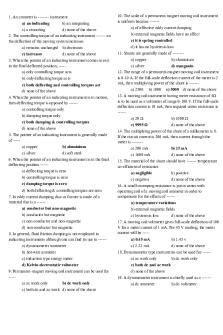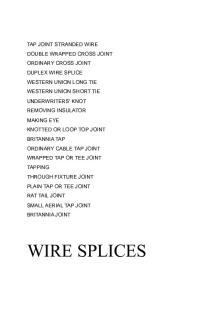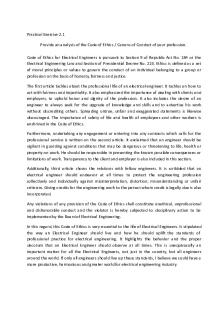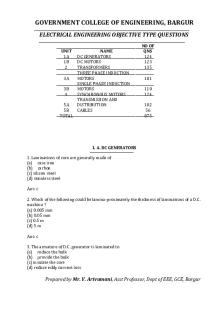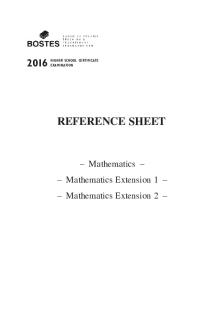2. Engineering Management electrical engineering board PDF

| Title | 2. Engineering Management electrical engineering board |
|---|---|
| Author | Chak Are |
| Course | Electrical engineering |
| Institution | Don Mariano Marcos Memorial State University |
| Pages | 24 |
| File Size | 191.5 KB |
| File Type | |
| Total Downloads | 3 |
| Total Views | 269 |
Summary
ENGINEERING MANAGEMENT Management is: A. An art B. Both science and art C. A science D. Neither art nor science Engineering is: A. An art B. Both science and art C. A science D. Neither art nor science Engineers can become good managers only through __. A. Experience B. Taking master degree in manag...
Description
ENGINEERING MANAGEMENT 1. Management is: A. An art B. Both science and art C. A science D. Neither art nor science 2. Engineering is: A. An art B. Both science and art C. A science D. Neither art nor science 3. Engineers can become good managers only through __________. A. Experience B. Taking master degree in management C. Effective career planning D. Trainings 4. If you are an engineer wanting to become a manager, what will you do? A. Develop new talents B. Acquire new values C. Broaden your point of view D. All of the above 5. When engineer enters management, what is the most likely problem he finds difficult to acquire? A. Learning to trust others B. Learning how to work through others C. Learning how to take satisfaction in the work of others D. All of the above 6. What management functions refers to the process of anticipating problems, analyzing them, estimating their likely impact and determining actions that will lead to the desired outcomes and goals? A. Planning B. Leading C. Controlling D. Organizing 7. What refers to the establishing interrelationships between people and things in such a way that human and materials resources are effectively focused toward achieving the goal of the company? A. Planning B. Leading C. Controlling D. Organizing 8. What management function involves selecting candidates and training personnel? A. Organizing B. Staffing C. Motivating D. Controlling 9. What management function involves orienting personnel in the most effective way and channeling resources? A. Directing
B. Planning C. Organizing D. Leading 10. Actual performance normally is the same as the original plan and therefore it is necessary to check for deviation and to take corrective action. This action refers to what management function? A. Organizing B. Planning C. Controlling D. Staffing 11. What refers to management function which is to encourage others to follow the example set for them, with great commitment and conviction? A. Staffing B. Motivating C. Controlling D. Leading 12. What refers to a principal function of lower management which is to instill in the workforce a commitment and enthusiasm for pursuing the goals of the organization? A. Directing B. Motivating C. Staffing D. Controlling 13. What refers to the collection of the tolls and techniques that are used on a predefined set of inputs to produce a predefined set of outputs? A. Project Management B. Engineering Management C. Management D. Planning 14. Which is NOT an element of project management process? A. Data and information B. Research and development C. Decision making D. Implementation and action 15. What is the most essential attribute of a project manager? A. Leadership B. Charisma C. Communication skill D. Knowledge 16. In project management, what provides a simple yet effective means of monitoring and controlling a project at each stage of its development? A. R & D model B. Project feasibility C. Life cycle model D. All of the above 17. What project life cycle model is the most relevant for information technology project? A. Morris model B. Waterfall model C. Incremental release model D. Prototype model 18. In project management, “R & D” stands for:
A. Retail Distribution B. Research and Development C. Repair and Develop D. Reduce and Deduce 19. In project management O & M stands for: A. Operation and Manpower B. Operation and Maintenance C. Operation and Management D. Operation and Mission 20. A project management must be very good in which of the following skills? A. Communication skills B. Human relationship skills C. Leadership skills D. All of the above 21. Project integration management involves which of the following processes? A. Project plan development B. Project plan execution C. Integrated change control D. Quality planning 22. Project quality management involves all of the following processes except: A. Quality planning B. Quality assurance C. Quality Control D. Quality feature 23. What is defined as an organized method of providing past, present, and projected information on internal operations and external intelligence for use in decision-making? A. Electronic Data Processing Systems B. Management Information System C. Central Processing System D. Data Management System 24. Middle management level undertakes what planning activity? A. Intermediate planning B. Strategic planning C. Operational planning D. Direct planning 25. Strategic planning is undertaken in which management level? A. Lower management level B. Middle management level C. Top management level D. Lowest management level 26. What is the advantage of free-rein style of leadership? A. Little managerial control and high degree of risk B. Time consuming and cost ineffective C. Little ideas from subordinate in decision- making D. All of the above 27. If you are appointed as a division manager, your first task is most likely to A. Set goals B. Determine the resources needed C. Set a standard D. Develop strategies and tactics
28. What is defined as the process of planning, organizing, and controlling operations to reach objective efficiently and effectively? A. General Management B. Engineering Management C. Production Management D. Operations Management 29. For a project manager to achieve his given set of goals through other people, he must have a good __________. A. Interpersonal skills B. Communication skills C. Leadership D. Decision- making skills 30. What type of conflict do managers encounter when there is disagreement on issues of territorial power or hidden agenda? A. Technical opinion conflict B. Politics C. Ambiguous roles D. Managerial procedure conflict 31. The process of partitioning an organization into subunits to improve efficiency is known as __________. A. Division of labor B. Segmentation C. Departmentalization D. Territorialization 32. By departmentalization of an organization, it decentralizes __________? A. Authority B. Responsibility C. Accountability D. All of the above 33. What type of committee companies or corporations created for a short term purpose only? A. Interim committee B. Temporary committee C. Standing committee D. Ad hoc committee 34. What refers to a description of whether the objectives are accomplished? A. Efficiency B. Effectiveness C. Ability to manage D. Decision- making ability 35. An engineering is required to finish a certain engineering job in 20 days. He is said to be __________ if he finished the job within the required period of 20 days A. Efficient B. Effective C. Reliable D. Qualified 36. If an engineer provides less input (labor and materials) to his project and still come out with the same output, he is said to be more __________. A. Managerial skill B. Economical
C. Effective D. Efficient 37. To determine a qualified applicant, the engineer manager will subject the applicant to a test that is used to measure a person’s current knowledge of a subject? A. Interest test B. Aptitude test C. Performance test D. Personality test 38. What type of training is a combination of on-the-job training and experience with classroom instruction in particular subject? A. On-the-job training B. Vestibule school C. Apprenticeship program D. In-basket 39. What type of authority refers to a specialist’s right to oversee lower level personnel involved in the project regardless of the personnel’s assignment in the organization? A. Top authority B. Line authority C. Staff authority D. Functional authority 40. When a consultant or specialist gives advice to his superior, he is using what type of authority? A. Top authority B. Line authority C. Staff authority D. Functional authority 41. When structuring an organization, the engineer manager must be concerned with the determining the scope of words and how it is combined in a job. This refers to __________. A. Division of labor B. Delegation of authority C. Departmentation D. Span of control 42. When structuring an organization, the engineer must be concerned with the grouping of related jobs, activities, or processes into major organizational subunits. This refers to: A. Division of labor B. Delegation of authority C. Departmentation D. Span of control 43. Which technique will the manager use when evaluating alternative using qualitative evaluation? A. Comparison technique B. Intuition and subjective judgment C. Rational technique D. Analytical technique 44. Which technique will the manager use when evaluating alternative using quantitative evaluation? A. Rational and analytical techniques B. Intuition and subjective judgment C. Comparison in number technique D. Cost analysis
45. What refers to the strategic statement that identifies why an organization exists, its philosophy of management, and its purpose as distinguished from other similar organizations in terms of products, services and markets? A. Corporate mission B. Corporate vision C. Corporate character D. Corporate identity 46. What refers to a process of influencing and supporting others to work enthusiastically toward achieving objectives? A. Power B. Leadership C. Teamwork D. Charisma 47. What describes how to determine the number of service units that will minimize both customer’s waiting time and cost of service? A. Queuing theory B. Network model C. Sampling theory D. Simulation 48. What refers to the rational way to conceptualize, analyze and solve problems in situations involving limited or partial information about the decision environment? A. Sampling theory B. Linear programming C. Decision theory D. Simulation 49. What is quantitative technique where samples of populations are statistically determined to be used for a number of processes, such as quality control and marketing research? A. Sampling theory B. Linear programming C. Statistical decision theory D. Simulation 50. The engineer manager must be concern with the needs of his human resources. What refers to the need of the employees for food, drinks, and rest? A. Physiological need B. Security need C. Esteem need D. Self - actualization need 51. What refers to the learning that is provided in order to improve performance on the present job? A. Training B. Development C. Vestibule D. Specialized courses 52. What technique is best suited for projects that contain many repetitions of some standard activities? A. Benchmark job technique B. Parametric technique C. Modular technique D. Non- modular technique
53. What organizational structure is based on the assumption that each unit should specialize in a specific functional area and perform all of the tasks that require its expertise? A. Functional organization B. Territorial organization C. Process organization D. Product organization 54. What type of organization structure in which each project is assigned to a single organizational unit and the various functions are performed by personnel within the unit? A. Functional organization B. Territorial organization C. Process organization D. Product organization 55. What organizational structure provides a sound basis for balancing the use of human resources and skills? A. Functional organization B. Matrix organization C. Process organization D. Product organization 56. In which type of organization where the structure can lead to a “dual boss” phenomenon? A. Functional organization B. Matrix organization C. Process organization D. Product organization 57. Which one is an advantage of a matrix organization? A. Rapid reaction organization B. Adaptation to changing environment C. State-of-the-art technology D. Better utilization of resources 58. Which one is a disadvantage of a matrix organization? A. Dual accountability of personnel B. Conflicts between project and functional managers C. Profit-and-loss accountability difficult D. Inefficient use of specialist 59. Which one is an advantage projectized organization? A. Efficient use of technical personnel B. Good project schedule and cost control C. Single point for customer contact D. Rapid reaction time possible 60. Which one is a disadvantage of a projectized organization? A. Uncertain technical direction B. Inefficient use of specialist C. Insecurity regarding future job assignments D. Slower work flow 61. Which one is an advantage of a functional organization? A. Efficient use of technical personnel B. Rapid reaction time possible C. Career continuity and growth of technical personnel D. Good technology transfer between projects 62. Which one is disadvantage of a functional organization?
A. Weak customer interface B. Weak project authority C. Inefficient use of specialist D. Slower work flow 63. In what type of organization where a project manager is held responsible for completion of the project and is often assigned a budget? A. Functional organization B. Matrix organization C. Projectized organization D. Project coordinated organization 64. In selecting an organizational structure, which of the following is not a criterion? A. Finance and accounting B. Customer relation C. Location D. Technology 65. What is NOT a factor to be taken into consideration when selecting an organizational structure for managing projects? A. Overhead cost B. Type of technology used C. Location of the project D. Level of uncertainty in projects 66. If a project have multidimensional goals, the project manager often use his __________ to reach a compromise solution. A. Leadership B. Tradeoff analysis skill C. Authority D. Decision-making skill 67. Who is responsible for ensuring that the project is completed successfully as measured by time, cost, performance and stakeholder satisfaction? A. Functional manager B. Project manager C. Chief engineer D. Department supervisor 68. Who is responsible for running a department so that all his customers are served efficiently and effectively? A. Area manager B. Sales manager C. Functional manager D. Project manager 69. What is the major activity of the project support office? A. Administrative support for projects B. Support for tools and techniques C. Overall project management support D. Project management via the internet 70. What is the major activity of the project office? A. Administrative support for projects B. Support for tools and techniques C. Overall project management support D. Project management via internet
71. What is an important tool for the design and implementation of the project’s work content? A. Linear responsibility chart B. Gantt chart C. Life cycle model D. Project design chart 72. What chart summarizes the relationships between project stakeholders and their responsibilities in each project element? A. Linear responsibility chart B. Matrix responsibility chart C. Responsibility interface matrix D. All of the above 73. What network model enables engineer managers to schedule, monitor, and control large and complex projects by using only one time factor per activity? A. Forecasting B. Critical path method C. Program evaluation review technique D. Simulation 74. What network model enables engineer managers to schedule, monitor, and control large and complex projects by employing three time estimate for each activity? A. Forecasting B. Critical path method C. Program evaluation review technique D. Simulation 75. For a project manager to have an effective means of identifying and communicating the planned activities and their interrelationships, he must use a network technique. One of the network techniques is commonly known as CPM. What does CPM stands for? A. Critical plan method B. Critical path method C. Critical project method D. Coordinated plan method 76. For a project manager to have an efficient means of identifying and communicating the planned activities and their interrelationships, he must use a network technique. One of the network techniques is commonly known as PERT. What does Pert stands for? A. Project evaluation review technique B. Program evaluation review technique C. Path evaluation review technique D. Program execution review technique 77. What is the benefit of using PERT/CPM network as integral component of project management? A. They furnish a consistent framework for planning, scheduling, monitoring and controlling project. B. They illustrate the interdependencies of all tasks C. They can be used to estimate the expected project completion dares as well as the probability that the project will be completed by a specific date D. All of the above 78. The CPM was developed by Rand and Walker in what year? A. 1957 B. 1958 C. 1959
D. 1960 79. In what year was PERT developed? A. 1957 B. 1958 C. 1959 D. 1960 80. In Morris life cycle model, a project is divided into how many stages to be performed in sequence? A. 3 B. 4 C. 5 D. 6 81. What is the first stage in the life cycle of a project using Morris model? A. Planning and design B. Feasibility C. Production D. Turnover and startup 82. Risk management is: A. Risk avoidance B. Controlling risk C. To gain opportunities D. All of the above 83. What technique a manager must use if he decides to absorb the risk in the project? A. Create buffer in the form of management reserve or extra time in schedule B. Use a different technology C. Use a different supplier D. Buying insurance 84. Buying insurance is a form of: A. Risk elimination B. Risk reduction C. Risk sharing D. Risk absorption 85. What refers to any technique used either to minimize the probability of an accident or to mitigate its consequences? A. Reliability management B. Risk management C. Quality assurance management D. Project assurance management 86. What refers to the techniques that encompass risk assignment and the inclusive evaluation of risk, costs and benefits of alternative projects or policies? A. Risk management B. Risk-benefit analysis C. Benefit management D. Uncertainty analysis 87. What is measured by the amount of resources that a manager can allocate without the need to get an approval from his or her manager? A. Responsibility B. Leadership C. Authority D. Tradeoff skill
88. What is defined as a course of action aimed at ensuring that the organization will achieve its objectives? A. Goal B. Strategy C. Program D. Plan 89. When there is a degradation of service provided by the company to clients, it is a sign that the engineer manager in-charge: A. Lacks leadership skill B. Has inadequate control C. Has poor organization D. Has no proper planning 90. What principal element of uncertainty refers to a measure of the relevance of available information to the problem at hand? A. Statistical confidence B. Tolerance C. Incompleteness of the data D. Ambiguity in modeling the problem 91. One of the mnemonic management tool used is the SMEAC. What does the acronym SMEAC stands for? A. Situation, Mission, Execution, Administration, Coordination B. Situation, Mission, Execution, Application, Communication C. Situation, Mission, Execution, Administration, Communication D. Strategy, Mission, Execution, Administration, Communication 92. In the management tools, SMEAC, where A stands for administration, which is the appropriate question will the manager ask? A. What do we need to get it done? B. What are we aiming to do? C. How are we going to do it? D. What is the operation environment? 93. In project management, what is usually the first step underlying in the process of performing a project? A. Select appropriate performance measures B. Define the goals of the project and their relative importance C. Identify a need for a product or service D. Develop a technological concept 94. In the process of performing a project, after the need for a product or service is identified, what is usually the next step? A. Define the goals of the project and their relative importance B. Develop a budget C. Develop a schedule D. Develop the technological concept 95. What is usually the last step in the process of performing a project? A. Select appropriate performance measures B. Implement a plan C. Monitor and control the project D. Evaluate project success 96. To consider the consequence of uncertainly on project management, laws on project management are developed. One of which is “A careless planned project will take __________ times longer to complete than expected”.
A. Three B. Four C. Two D. Two and a half 97. In the typical functional organization hierarchy, the chief engineer is under the __________. A. Finance manager B. Manufacturing manager C. General manager D. Mar...
Similar Free PDFs
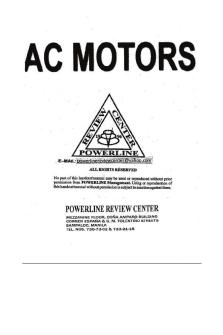
AC Motors101 Electrical Engineering
- 17 Pages

Electrical engineering - Wikipedia
- 18 Pages

Controlling -Engineering Management
- 23 Pages
Popular Institutions
- Tinajero National High School - Annex
- Politeknik Caltex Riau
- Yokohama City University
- SGT University
- University of Al-Qadisiyah
- Divine Word College of Vigan
- Techniek College Rotterdam
- Universidade de Santiago
- Universiti Teknologi MARA Cawangan Johor Kampus Pasir Gudang
- Poltekkes Kemenkes Yogyakarta
- Baguio City National High School
- Colegio san marcos
- preparatoria uno
- Centro de Bachillerato Tecnológico Industrial y de Servicios No. 107
- Dalian Maritime University
- Quang Trung Secondary School
- Colegio Tecnológico en Informática
- Corporación Regional de Educación Superior
- Grupo CEDVA
- Dar Al Uloom University
- Centro de Estudios Preuniversitarios de la Universidad Nacional de Ingeniería
- 上智大学
- Aakash International School, Nuna Majara
- San Felipe Neri Catholic School
- Kang Chiao International School - New Taipei City
- Misamis Occidental National High School
- Institución Educativa Escuela Normal Juan Ladrilleros
- Kolehiyo ng Pantukan
- Batanes State College
- Instituto Continental
- Sekolah Menengah Kejuruan Kesehatan Kaltara (Tarakan)
- Colegio de La Inmaculada Concepcion - Cebu


